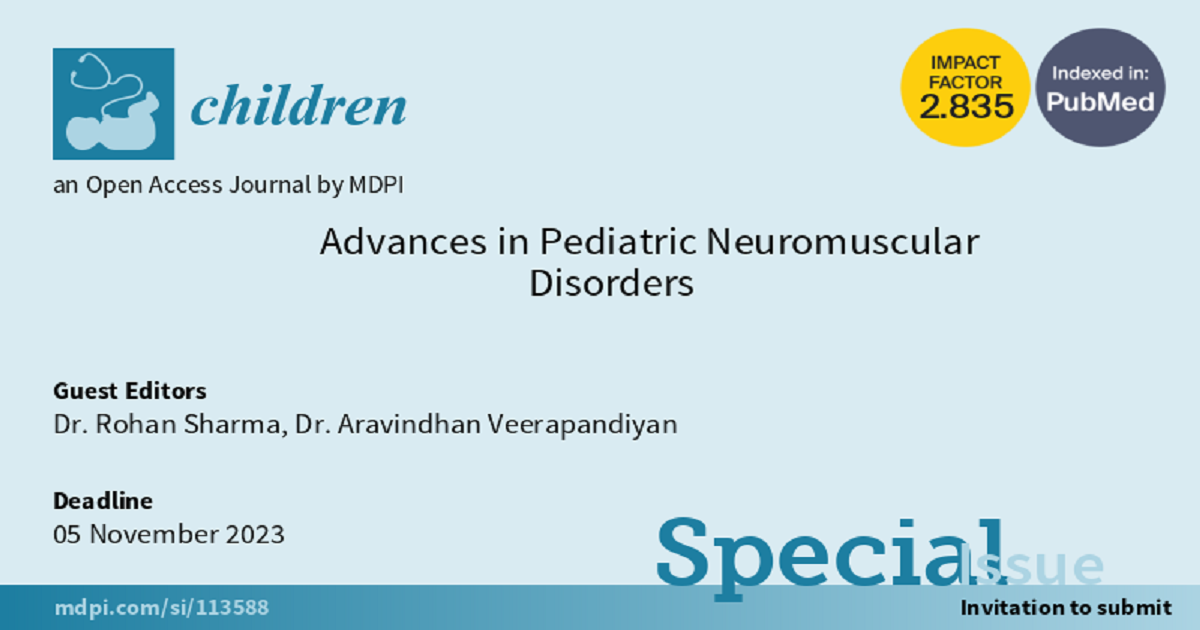Advances in Pediatric Neuromuscular Disorders
A special issue of Children (ISSN 2227-9067). This special issue belongs to the section "Pediatric Neurology & Neurodevelopmental Disorders".
Deadline for manuscript submissions: closed (5 November 2023) | Viewed by 22083

Special Issue Editors
Interests: neuromuscular disorders; critical care; neuroimmunology
Interests: neuromuscular disorders; gene therapy; neuroimmunology
Special Issues, Collections and Topics in MDPI journals
Special Issue Information
Dear Colleagues,
In the last decade, therapies for pediatric neuromuscular disorders have made a quantum leap. Diseases such as spinal muscular atrophy and Pompe disease, which were once untreatable, now have multiple therapies that span from enzyme replacement therapy, post-transcription RNA modulars to gene therapy. Life expectancy and quality of life has improved for patients with Duchenne muscular dystrophy and other muscular dystrophies. Newer and safer agents are now available for previously treatable disorders such as myasthenia gravis. Ongoing, multifaceted research is taking place with regard to early diagnosis, treatment and remedies to improve quality of life and outcome for various neuromuscular disorders. Additionally, like everything in medicine, COVID-19 has introduced a new paradigm of neuromuscular diseases. This Special Issue aims to explore the frontier of the evolving field of neuromuscular medicine.
Dr. Rohan Sharma
Dr. Aravindhan Veerapandiyan
Guest Editors
Manuscript Submission Information
Manuscripts should be submitted online at www.mdpi.com by registering and logging in to this website. Once you are registered, click here to go to the submission form. Manuscripts can be submitted until the deadline. All submissions that pass pre-check are peer-reviewed. Accepted papers will be published continuously in the journal (as soon as accepted) and will be listed together on the special issue website. Research articles, review articles as well as short communications are invited. For planned papers, a title and short abstract (about 100 words) can be sent to the Editorial Office for announcement on this website.
Submitted manuscripts should not have been published previously, nor be under consideration for publication elsewhere (except conference proceedings papers). All manuscripts are thoroughly refereed through a single-blind peer-review process. A guide for authors and other relevant information for submission of manuscripts is available on the Instructions for Authors page. Children is an international peer-reviewed open access monthly journal published by MDPI.
Please visit the Instructions for Authors page before submitting a manuscript. The Article Processing Charge (APC) for publication in this open access journal is 2400 CHF (Swiss Francs). Submitted papers should be well formatted and use good English. Authors may use MDPI's English editing service prior to publication or during author revisions.
Keywords
- neuromuscular disorders
- spinal muscular atrophy
- Duchenne Muscular dystrophy
- Limb Girdle Muscular dystrophy
- Charcot-Marie-Tooth Disease
- myotonic dystrophy
- plexopathy
- neuropathy
- neuromuscular junction disorders
- myopathy
Benefits of Publishing in a Special Issue
- Ease of navigation: Grouping papers by topic helps scholars navigate broad scope journals more efficiently.
- Greater discoverability: Special Issues support the reach and impact of scientific research. Articles in Special Issues are more discoverable and cited more frequently.
- Expansion of research network: Special Issues facilitate connections among authors, fostering scientific collaborations.
- External promotion: Articles in Special Issues are often promoted through the journal's social media, increasing their visibility.
- Reprint: MDPI Books provides the opportunity to republish successful Special Issues in book format, both online and in print.
Further information on MDPI's Special Issue policies can be found here.






